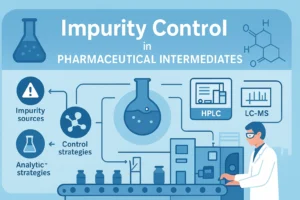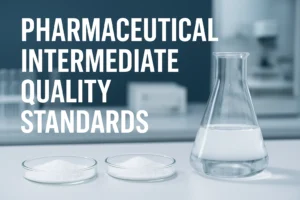The COA Verification Tool (Certificate of Analysis Verification Tool) is a digital tool used in the pharmaceutical, chemical, food and other industries to automatically verify the authenticity and compliance of product quality inspection reports.
It uses technical means to solve the trust pain points in the supply chain, which is especially important for purchasers of pharmaceutical intermediates, APIs, etc.
If you’re sourcing raw materials, intermediates, or active pharmaceutical ingredients (APIs), that COA isn’t just paperwork – it’s the bedrock of trust, safety, and regulatory compliance.
But here’s the uncomfortable truth: fake or tampered COAs exist. Relying on one can derail your production, compromise product safety, and land you in serious regulatory hot water.
So, how do you know if the COA you’re holding is genuine? That’s where COA verification tools and smart practices come into play. Think of it as due diligence for your supply chain integrity.
Why COA Verification Isn’t Optional (It’s Essential)
Before diving into the how, remember the why:
- Product Safety & Efficacy: An inaccurate COA means you don’t truly know what you’re using. Impurities, incorrect potency, or undisclosed solvents pose huge risks.
- Regulatory Compliance (GMP, ISO, etc.): Regulators (FDA, EMA, etc.) demand traceable, verifiable proof of material quality. A fake COA is a compliance nightmare.
- Supply Chain Integrity: Verifying COAs helps combat counterfeit materials entering your process.
- Your Reputation & Liability: Selling products made with misrepresented materials destroys trust and opens you to legal action.
Red Flags: The Manual First Line of COA Defense
Before even reaching for digital tools, scrutinize the document itself. A good COA verification tool starts with your own eyes:
- Supplier Consistency: Does the format, logo, and branding match what you know from this supplier? Sudden changes without explanation are suspicious.
- Critical Data Check: Are all mandatory fields present? Look for:
- Clear Supplier Name & Complete Address
- Unique Certificate Number
- Precise Product Name (including grade) and Batch/Lot Number
- Date of Manufacture and Date of Expiry/Retest
- Clear Test Specifications (e.g., USP, EP, BP, or internal specs) and Actual Results
- Defined Acceptance Criteria (Pass/Fail)
- Authorized Signatory with Name, Title, and Date of Signature
- Laboratory Information (if tested by a 3rd party)
- Signature & Stamp Authenticity: Is the signature consistent with previous COAs? Are stamps clear, not blurry or pixelated (signs of copying)? Does it look like a real stamp was applied, or just an image pasted on?
- Logical Consistency: Do the dates make sense? Does the batch number format align with the supplier’s typical format? Are the test results *too* perfect, hitting every spec exactly?
- Watermarks & Security Features: Many reputable suppliers use security paper with watermarks, holograms, or special inks. Check for these. Their absence, especially if previously used, is a warning.
Beyond the Eye Test: Digital COA Verification Tools
This is where technology significantly boosts your ability to validate COA authenticity. Here’s what modern COA verification tools look like:
- Supplier Portal Verification:
- How it Works: Reputable suppliers often host secure online portals where you can log in, enter the COA number and/or batch number, and instantly retrieve and cross-check the official electronic version.
- Verification Power: This is often the gold standard. Matching the physical document to the immutable digital record in the supplier’s system offers high confidence. Look for portals using secure logins (like SSO or unique credentials).
- QR Code / Barcode Integration:
- How it Works: Increasingly, COAs feature a QR code or barcode. Scanning it with a dedicated app (provided by the supplier or integrated into inventory/quality systems) takes you directly to the verified digital COA record on the supplier’s server.
- Verification Power: Provides a quick link to the source of truth. Ensure the scanned data exactly matches the data on your paper/PDF COA (batch number, product, dates).
- Blockchain-Based Verification:
- How it Works: Emerging solutions use blockchain technology. The COA data (or a secure cryptographic hash of it) is immutably recorded on a blockchain ledger when issued. You can then verify the document’s integrity and origin against this ledger.
- Verification Power: Offers high tamper-resistance and traceability. While not yet ubiquitous, it’s a powerful future-proof COA verification tool.
- Digital Signature Validation:
- How it Works: Electronic COAs signed with qualified digital signatures (like those compliant with eIDAS in the EU or similar standards) provide cryptographic proof of the signer’s identity and that the document hasn’t been altered since signing.
- Verification Power: PDF readers often have built-in signature validation panels. Check for a Valid status and confirm the signer’s certificate details match the supplier.
- API-Driven Verification Systems:
- How it Works: Large buyers or those using sophisticated Quality Management Systems (QMS) or ERP systems can integrate directly with a supplier’s system via secure APIs. This allows for automated checking of COA data upon receipt against the supplier’s master data.
- Verification Power: Enables high-volume, automated verification, reducing manual effort and risk.
Building Trust Through Verification: Your Verification Workflow
Don’t rely on just one method. Combine them for robust EEAT (Experience, Expertise, Authoritativeness, Trustworthiness) in your quality process:
- Receive: Get the COA (physical or digital).
- Initial Scrutiny: Perform the manual “red flag” checks immediately.
- Digital Verification: Use the appropriate tool(s):
- Scan the QR/barcode.
- Log into the supplier portal and search by COA/Batch number.
- Validate the digital signature.
- (If applicable) Check blockchain status.
- Cross-Check: Ensure all data (product, batch, specs, results, dates) matches perfectly between the document you have and the verified source.
- Document & Archive: Record your verification steps and outcome. Store the verified COA securely (digitally is best for searchability).
The Cost of Skipping Verification
Saving a few minutes skipping COA verification is a dangerous gamble. The consequences of a fake COA – product recalls, regulatory actions, production shutdowns, lawsuits, reputational ruin – dwarf the time invested in proper COA validation.
Partner with Suppliers Who Prioritize Transparency
Ultimately, the easiest verification happens with suppliers committed to transparency and robust systems. Look for partners who:
- Offer secure online portals or QR code verification.
- Use clear security features on paper COAs.
- Issue electronically signed COAs.
- Are responsive to verification requests.
Your Trusted Source for Quality & Transparent COAs
At Tianming Pharmaceutical, we understand that COA verification is fundamental to your success and compliance. As a leading manufacturer of high-quality APIs and intermediates, we prioritize integrity at every step:
- Instant Digital Access: All our COAs are available instantly via our secure online customer portal.
- Tamper-Evident Design: Our physical COAs incorporate security features.
- Clear, Comprehensive Data: We provide detailed, accurate test results against agreed specifications.
- Dedicated Support: Our quality team is readily available to address any verification questions.
Don’t gamble with your materials. Make COA verification a non-negotiable step. Implement these tools and practices to build a safer, more compliant, and trustworthy supply chain.
Ready to source APIs and intermediates with guaranteed, easily verifiable quality? Contact Tianming Pharmaceutical today to discuss your requirements and experience the difference transparent documentation makes.



